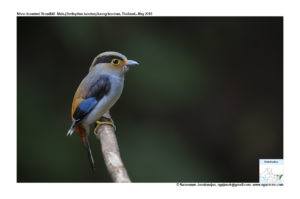
Silver-breasted Broadbill Serilophus lunatus
Etymology:
- Serilophus : Greek word serikos- silken; lophos -crest { Smooth crest}
- Lunatus: Latin word for Crescent-shaped, Sickle-shaped.
Vernacular names: Lepcha: Rab kyul, Cachar: Dao hungari, Nepal: Rai suya
Distribution in India: Resident of Himalayan foothills and North East India.
Description: Size of 16–17 cm; Wt. of 25·2–34 g. The male has a pale rusty head, lores usually darker rusty, forehead often ash-grey, and broad black supercilium. The upperparts are ferruginous, greyer on mantle, has bright rufous rump and uppertail-coverts. The wing-coverts are blackish; flight-feathers are strikingly blue and black, with white band at base. The tertials are orange-rufous; tail is black, outer feathers are tipped white. It is pale ash-grey below, becoming white on belly and undertail-coverts. The iris is green to dark blue with yellowish orbital ring; bill is blue to greenish blue with orange base; legs and feet are yellowish to olive. The female is like male, but has a narrow silver band on upper breast. The juvenile resembles adult, but wings and tail are much shorter, with rusty suffusion to cap and mantle, and ear-coverts always ash-grey.
Habitat: It is found in tropical and subtropical evergreen and semi-evergreen forest, also mixed deciduous forest. It is found from 300 m – 2200 m.
Food Habits: It eats Invertebrates, primarily insects. Insects taken by flycatching from perch, moving from one perch to another, although flight heavy and awkward; more often by gleaning branches and foliage, from undergrowth to below the canopy, but mainly in mid-storey and understorey. It also extracts larvae from tree bark. It forages in pairs or in loose. It will also join mixed-species flocks foraging in understorey
Breeding Habits: They breed in Mar–Jul in Myanmar, May-July in India, Aug–Dec in North Thailand and Mar–May in South Thailand; Mar–Jun in Vietnam; Mar–Jun in Peninsular Malaysia; Mar in Sumatra. The nest is a pendant ball with long, loose hanging “tail”, usually neater-looking than those of most other broadbills. The nest is built by both sexes, sometimes with helpers, in 5–10 day. The nest is built with, material including coarse grass, outer bark of elephant grass, weeds, thin twigs, fine roots and fungal hyphae, frayed palm pieces and green moss, interior lining of broad grass blades, green leaves and other material, green leaves are regularly replaced during incubation. The nest tail may be decorated with moss, lichen, spider egg cases and other material after eggs are laid. The nest has a circular entrance hole with “hood” projecting outwards and suspended across entire width by mass of interwoven plant fibers from outer branch of small tree, tip of palm frond or bamboo, or bush or tree-fern, over open space such as road, path or small stream. If nest is destroyed, the replacement is usually built nearby. They lay a clutch of 2–7 eggs. Incubation is done by both sexes.